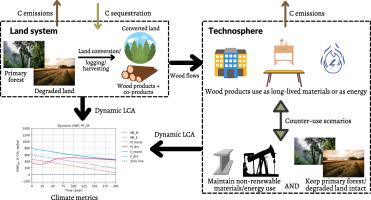Science of the Total Environment ( IF 8.2 ) Pub Date : 2021-09-10 , DOI: 10.1016/j.scitotenv.2021.150226 Rio Aryapratama 1 , Stefan Pauliuk 1

|
Wood-based products can contribute to climate change mitigation by prolonging the storage of carbon in the anthroposphere. In Indonesia, however, many wood-based products originate from unsustainable sources due to widespread land-use changes over the past decades. To reconcile economic development and climate policy, a detailed and comprehensive carbon life cycle assessment is needed, covering biospheric and technospheric woody carbon flows and emissions over time. In this study, we combine dynamic material flow analysis, stock modeling, and life cycle assessment to estimate life cycle carbon emissions over time of wood products from different land conversion types in Indonesia on a hectare (ha) basis. Wood production from clear-cut primary forest conversions to oil palm, secondary forest, and timber plantations lead to net carbon emissions between 1206–1282, 436–449, and 629–958 t-CO2-eq/ha, respectively, at the end of the 200-year time horizon (TH). The counter-use scenarios of using non-renewable materials or energy instead of wood-based products for the same set of scenarios while leaving primary forests untouched display 44–57, 59–88, and 5–48% lower global warming potentials, respectively, at the end of the TH. Wood products from forest plantations on restored degraded land (DL_FP), reduced-impact logging (RIL), and improved reduced-impact logging (RIL-C) of primary forest went beyond carbon neutrality, displaying carbon removal potentials of up to around −218, −378, and −739 t-CO2-eq/ha, respectively, by year 200. At the one ha-scale, our results indicate that keeping primary forests intact is the climate-preferable option, even when emissions from the counter-use of non-renewable materials or energy are factored in, except if RIL is performed. Therefore, wood product utilization would only be favorable from a climate perspective in DL_FP or RIL pathways. These results help screen different land conversion policy options and providing information about the climate mitigation potential of wood products in different supply chains.
中文翻译:

印度尼西亚不同土地转化和木质生物质利用情景的生命周期碳排放
木质产品可以通过延长人类圈中的碳储存时间来缓解气候变化。然而,在印度尼西亚,由于过去几十年土地利用的广泛变化,许多木质产品源自不可持续的来源。为了协调经济发展和气候政策,需要进行详细而全面的碳生命周期评估,涵盖生物圈和技术圈木本碳随时间的流动和排放。在本研究中,我们结合动态物质流分析、库存建模和生命周期评估,以公顷 (ha) 为基础估算印度尼西亚不同土地转化类型的木制品随时间的生命周期碳排放。从砍伐的原始林转变为油棕、次生林、在 200 年时间范围 (TH) 结束时分别为2 -eq/ha。在同一组场景中使用不可再生材料或能源代替木质产品同时保持原始森林不变的反使用场景分别显示全球变暖潜势降低 44-57%、59-88% 和 5-48% , 在 TH 的末尾。来自恢复退化土地 (DL_FP)、减少影响的伐木 (RIL) 和改善的原始森林减少影响的伐木 (RIL-C) 的人工林的木材产品超越了碳中和,显示出高达 -218 左右的碳去除潜力, -378 和 -739 t-CO 2-eq/ha,分别为到 200 年。 在一个公顷的范围内,我们的结果表明,即使考虑到不可再生材料或能源的反用途造成的排放,保持原始森林完整是气候优选的选择在,除非执行 RIL。因此,从气候角度来看,在 DL_FP 或 RIL 途径中,木材产品的利用是有利的。这些结果有助于筛选不同的土地转换政策选项,并提供有关不同供应链中木材产品减缓气候变化潜力的信息。











































 京公网安备 11010802027423号
京公网安备 11010802027423号